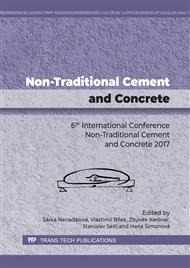p.45
p.49
p.57
p.61
p.65
p.69
p.73
p.79
p.83
Pore Solution Composition and Solubility of Alkali-Activated Fly Ash
Abstract:
Pore solution of hardened alkali-activated fly ash paste was extracted by the steel-die method. The aqueous phase composition of pore solution was analyzed using ICP-OES analysis technique. The results show that the concentrations of Si, Al, Ca, K and OH- decrease with curing time regardless of the curing temperatures (40°C/60°C) and alkaline activators (sodium hydroxide with/without sodium silicate). On the contrary, the concentration of S increases with curing time. A higher temperature curing decreases the solubility of Si, Al, Ca and K in the alkali-activated fly ash, while it doesn’t show much influence on the solubility of S. The plot of the concentration of Al versus the concentration of Si displays a quasi-linear logarithmic relationship. This relationship implies congruent removal of Si and Al from the frameworks of fly ash.
Info:
Periodical:
Pages:
65-68
Citation:
Online since:
January 2018
Authors:
Keywords:
Price:
Сopyright:
© 2018 Trans Tech Publications Ltd. All Rights Reserved
Share:
Citation:


